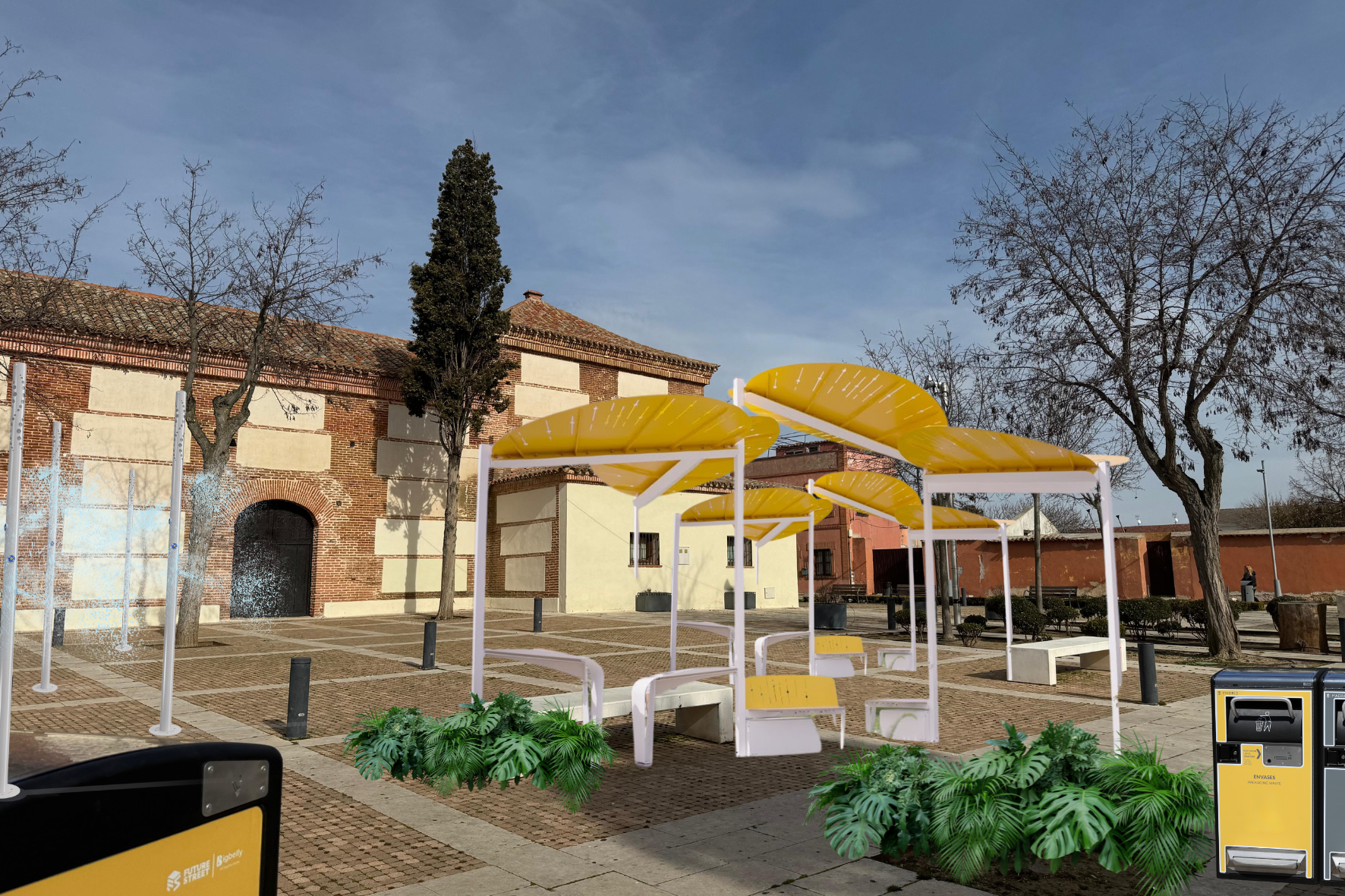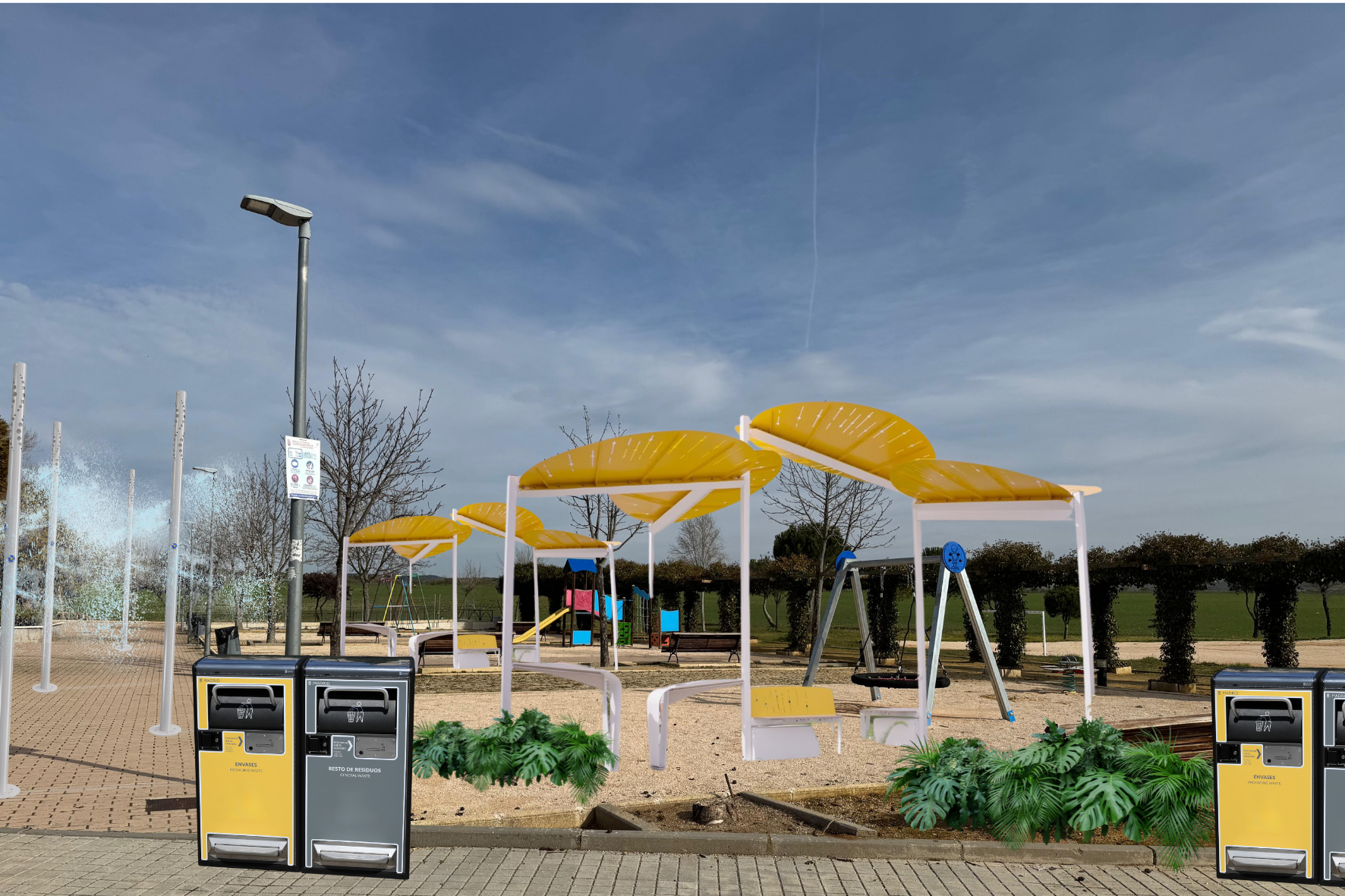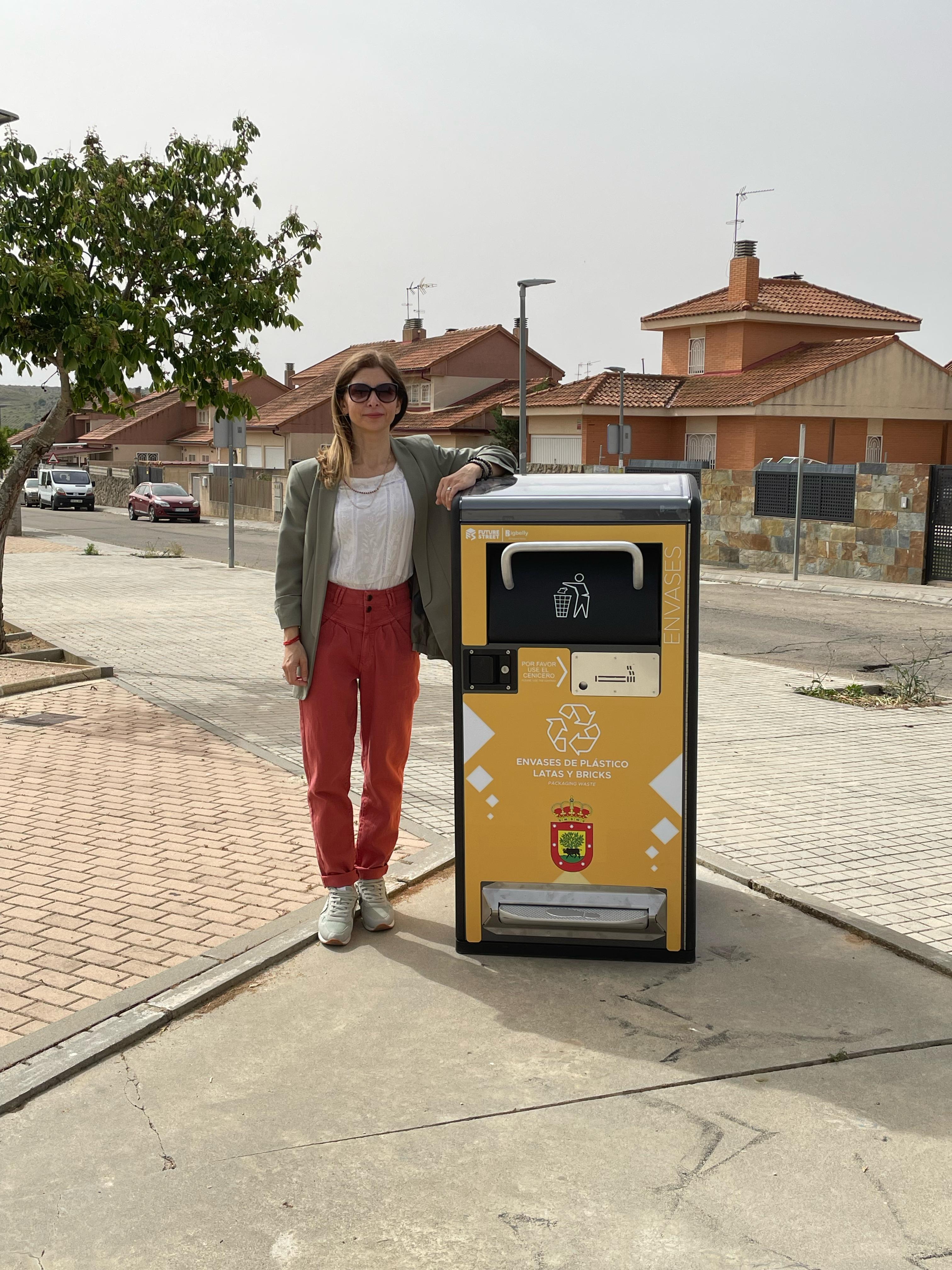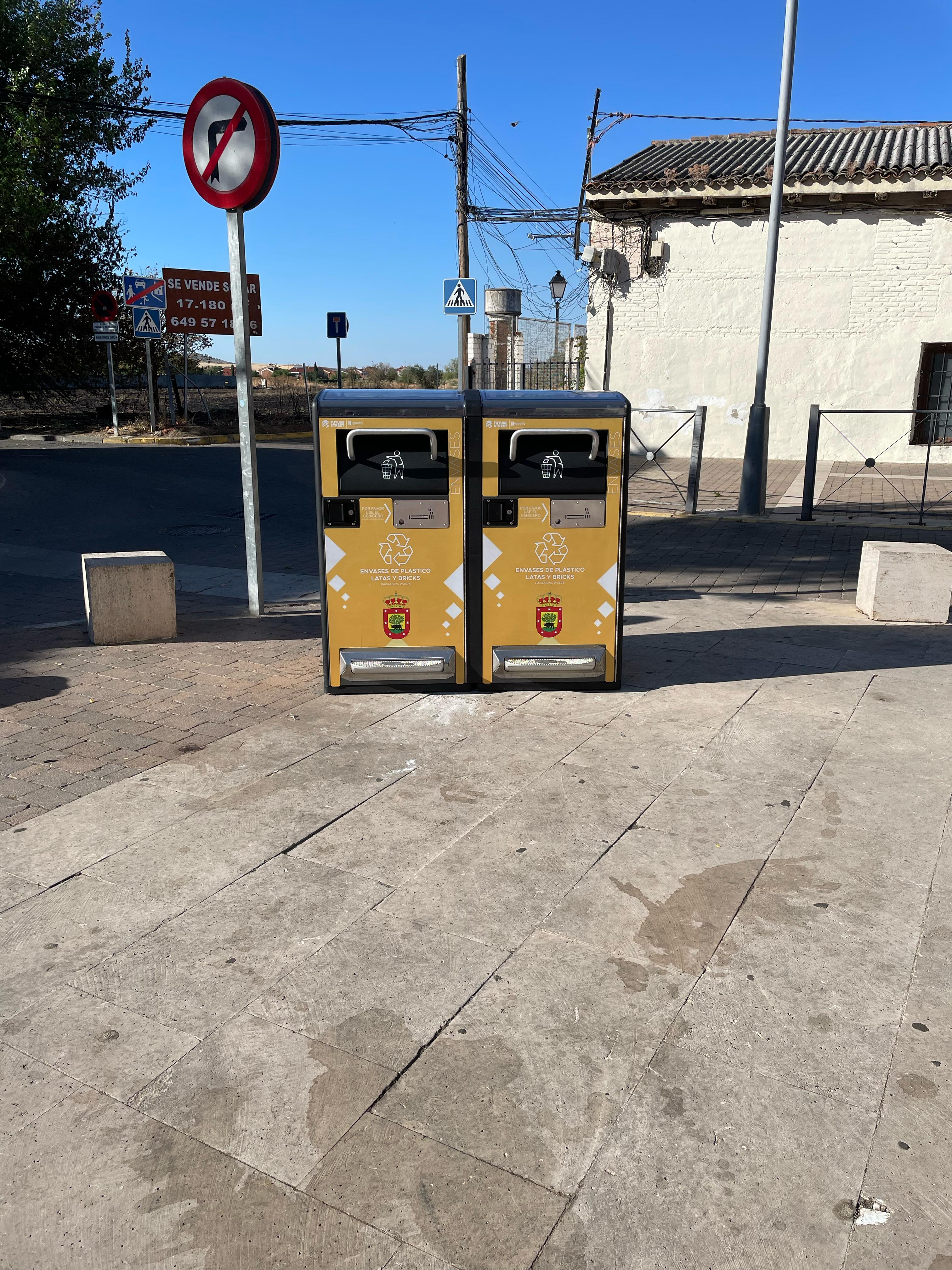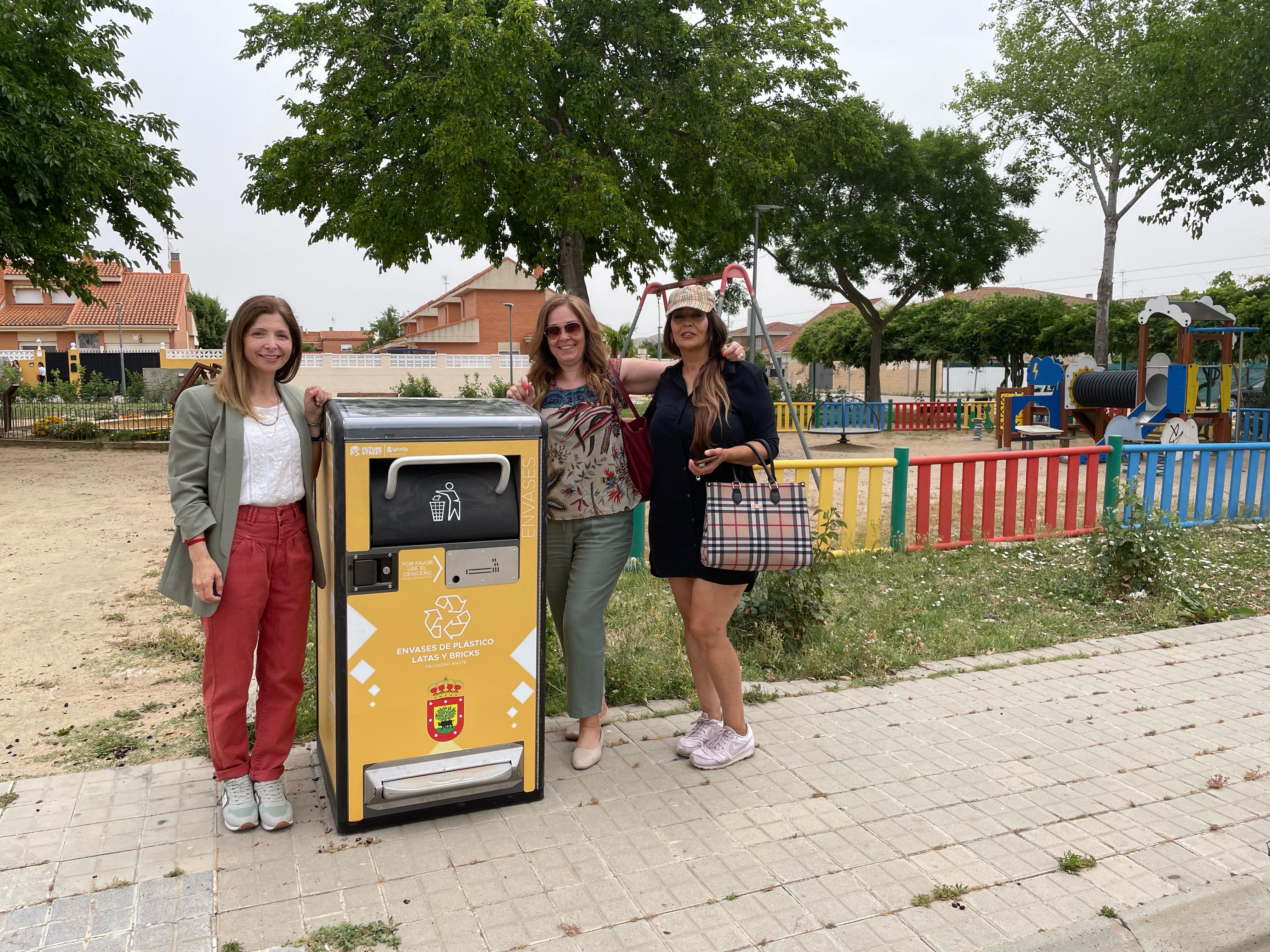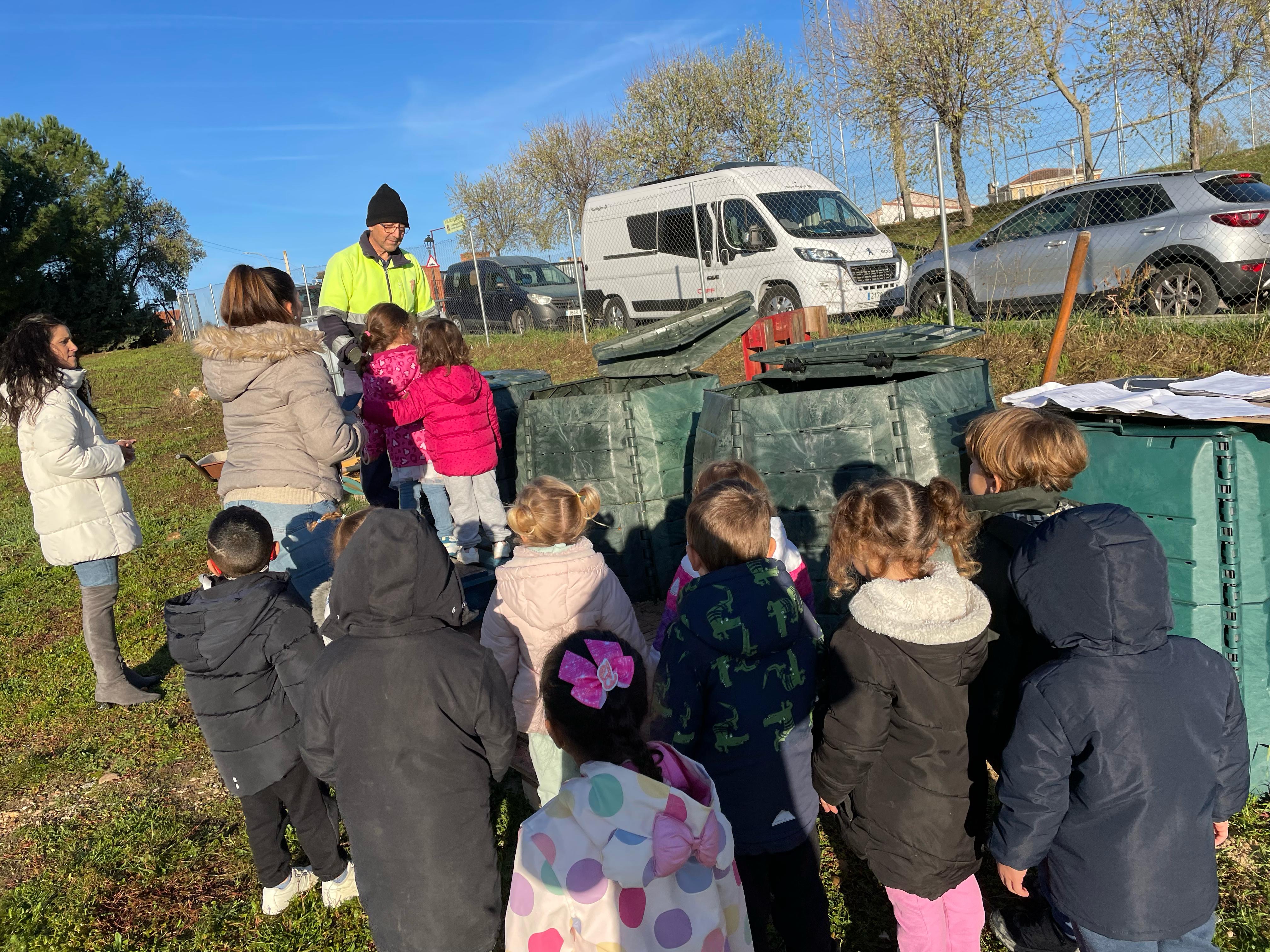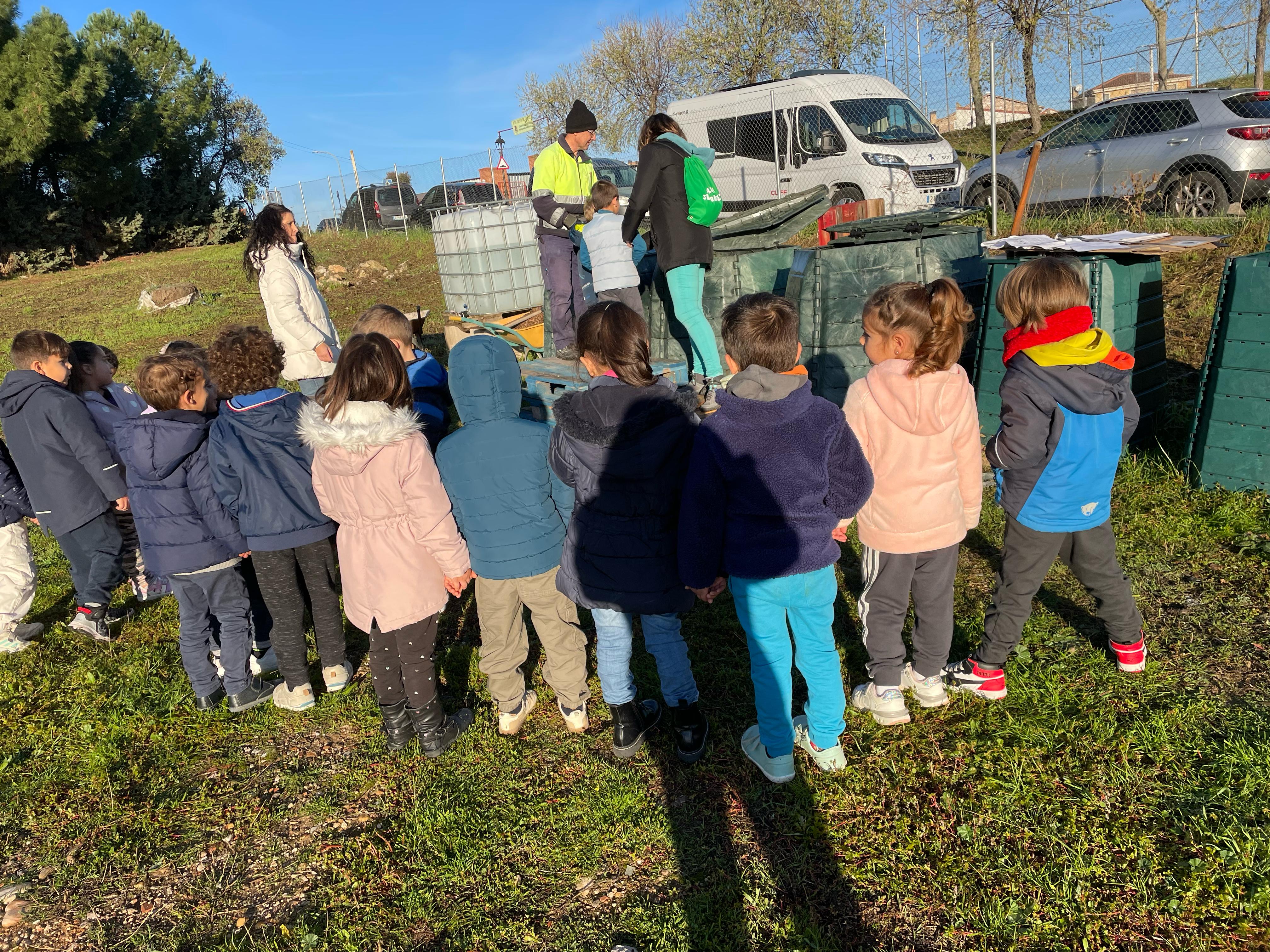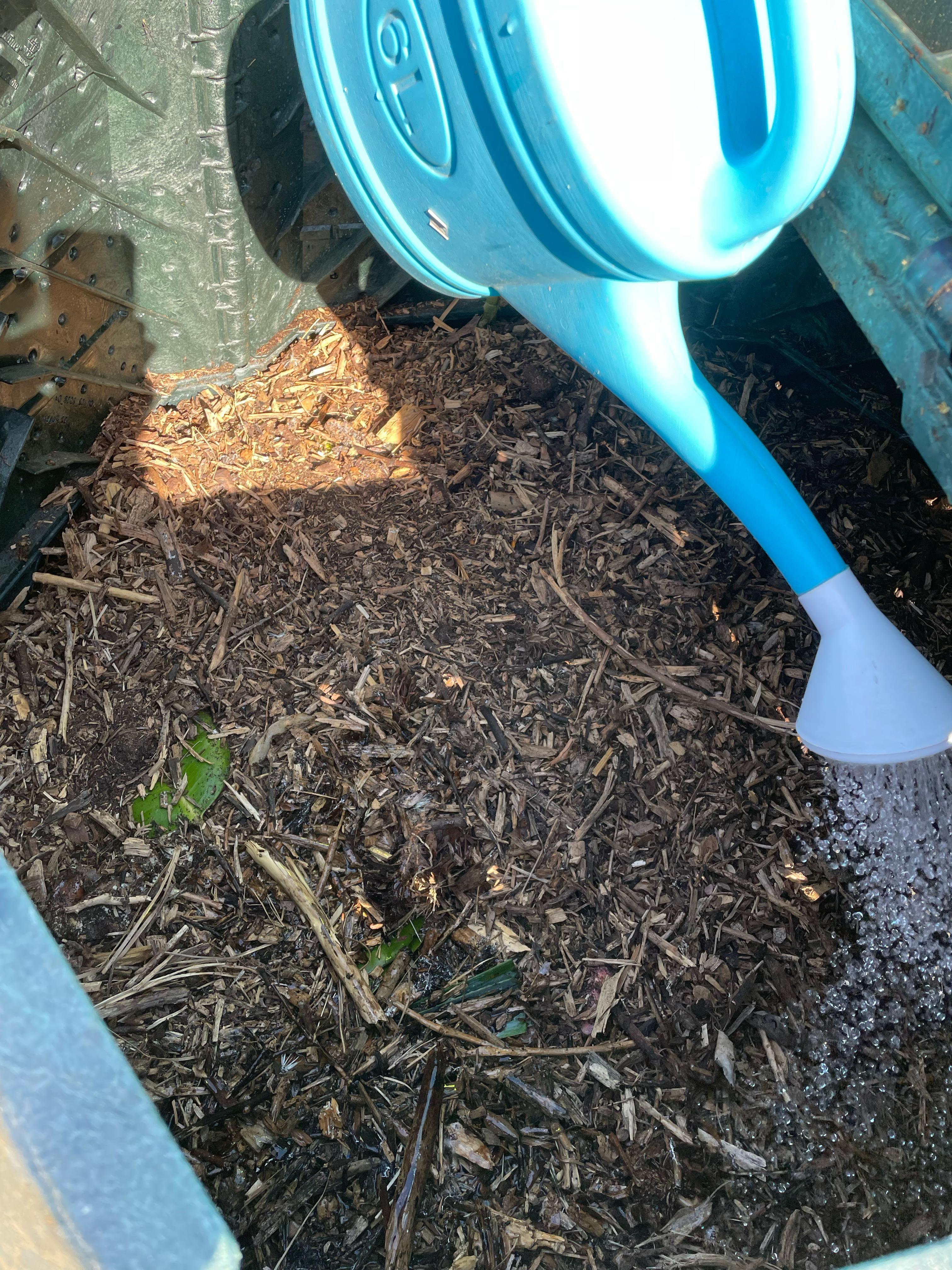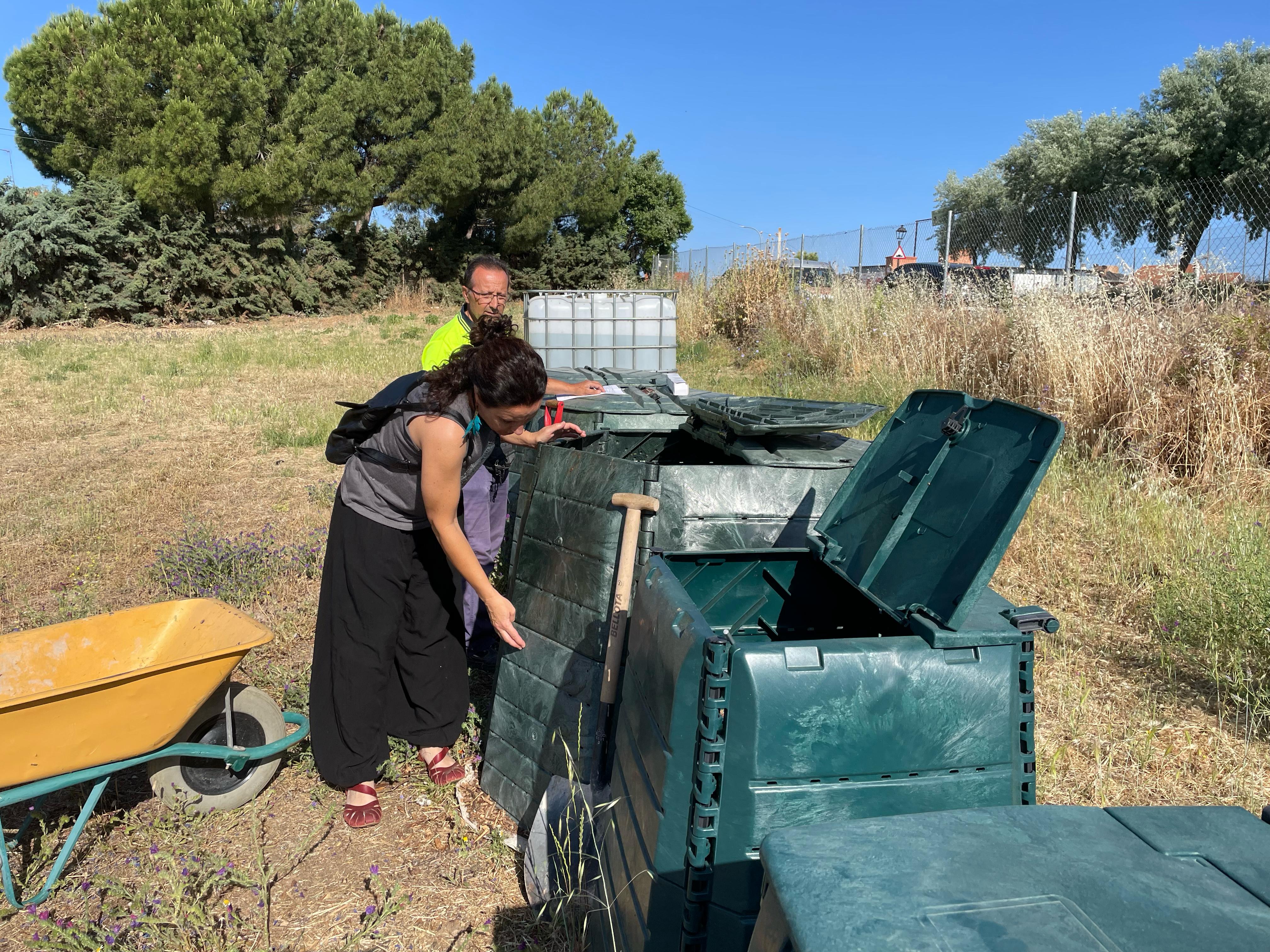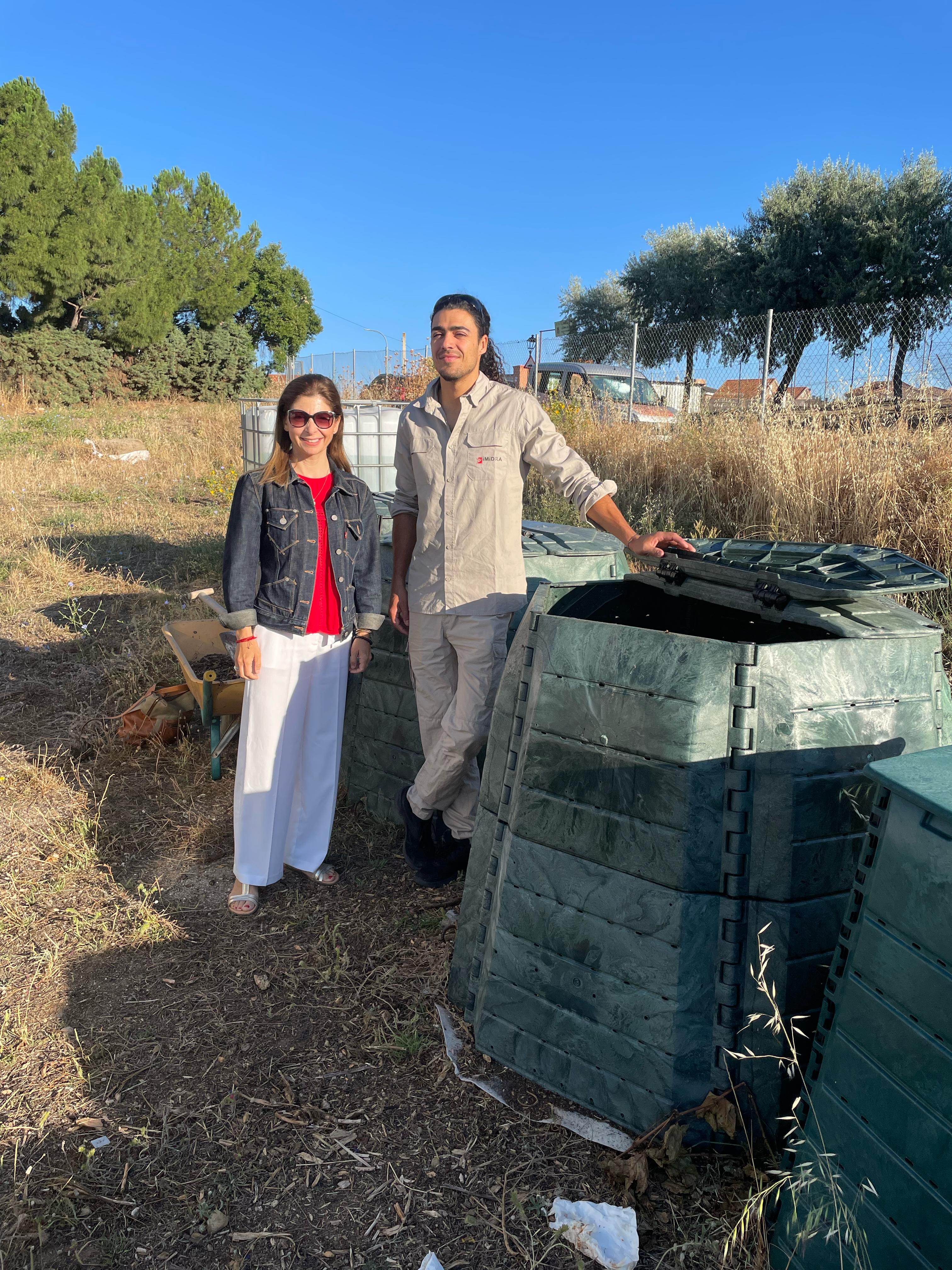Sustainable and Inclusive Parks
Sustainable Parks with Bioclimatic Shelters
The project in Fresno de Torote focuses on creating sustainable and inclusive parks and bioclimatic shelters. This effort is supported by a door-to-door selective collection of organic waste, community composting, and the installation of smart bins. The overall objective is to promote environmental sustainability, foster social inclusion, and enhance residents’ quality of life through eco-friendly practices and innovative technologies.
Spain
It has been implemented in one of the most frequently visited parks in our municipality, known as Parque de la Reguerilla, which is a central gathering place offering playgrounds, green areas, and sports zones for a wide range of community members. In Calle de Infante García s/n, Serracines, Fresno de Torote.
Prototype level
Yes
Yes
Yes
No
No
28057: Fresno de Torote (ES)
1. Overall Goal:
o Encourage sustainability and improve the environment through organic waste management.
o Offer climate shelters and walkable fountains, especially during extreme heat episodes, for the well-being of the entire community.
2. Target Groups:
o Children and youth, families, seniors, tourists, and sports enthusiasts.
3. Specific Objectives:
o Reduce the cost of collecting, transporting, and treating organic waste.
o Improve soil quality and biodiversity in municipal parks.
o Promote circular economy practices and environmental responsibility among residents and the local education community.
4. Expected Results:
o Economic: Decreased waste management costs, reduced chemical fertilizer purchases, optimized recycling, and water savings.
o Environmental: Lower greenhouse gas emissions, improved soil quality, enhanced biodiversity, and outdoor cooling during heatwaves.
o Social: Greater environmental awareness, improved community well-being, and more responsible use of water resources, leading to a higher quality of life for residents.
5. Monitoring and Measurement of Results
In order to assess the effectiveness of each component of the project, we will establish monitoring and measurement indicators, including:
o Reduction in the volume of organic waste sent to landfills (in kg/year).
o Amount of compost produced and applied in parks (in kg/year).
o Number of participating households in the door-to-door collection and monthly evolution.
o Occupancy rate of bioclimatic shelters during periods of extreme heat.
o Water and energy savings resulting from the installation of smart irrigation systems and walkable fountains.
o Citizen participation in workshops and activities (attendance, satisfaction surveys).
o These indicators will enable us to measure the environmental, economic, and social impact of the project, as well as adjust measures in real time to maximize efficiency and replicability.
o Encourage sustainability and improve the environment through organic waste management.
o Offer climate shelters and walkable fountains, especially during extreme heat episodes, for the well-being of the entire community.
2. Target Groups:
o Children and youth, families, seniors, tourists, and sports enthusiasts.
3. Specific Objectives:
o Reduce the cost of collecting, transporting, and treating organic waste.
o Improve soil quality and biodiversity in municipal parks.
o Promote circular economy practices and environmental responsibility among residents and the local education community.
4. Expected Results:
o Economic: Decreased waste management costs, reduced chemical fertilizer purchases, optimized recycling, and water savings.
o Environmental: Lower greenhouse gas emissions, improved soil quality, enhanced biodiversity, and outdoor cooling during heatwaves.
o Social: Greater environmental awareness, improved community well-being, and more responsible use of water resources, leading to a higher quality of life for residents.
5. Monitoring and Measurement of Results
In order to assess the effectiveness of each component of the project, we will establish monitoring and measurement indicators, including:
o Reduction in the volume of organic waste sent to landfills (in kg/year).
o Amount of compost produced and applied in parks (in kg/year).
o Number of participating households in the door-to-door collection and monthly evolution.
o Occupancy rate of bioclimatic shelters during periods of extreme heat.
o Water and energy savings resulting from the installation of smart irrigation systems and walkable fountains.
o Citizen participation in workshops and activities (attendance, satisfaction surveys).
o These indicators will enable us to measure the environmental, economic, and social impact of the project, as well as adjust measures in real time to maximize efficiency and replicability.
Sustainability
Reduction
Participation
Bioclimatic
Beautification
Sustainable Objectives:
1. Promote sustainability through organic waste management.
2. Improve soil quality and biodiversity in municipal parks.
3. Provide climatic shelters for the community, especially during extreme heatwaves.
4. Raise awareness and educate citizens about environmental responsibility.
Key Sustainable Components:
• Door-to-Door Organic Waste Collection (Achieved):
o Collection occurs twice a week for approximately 500 families (50 currently active, plus a school and daycare).
o Potential annual organic waste: up to 350 kg per family, totaling approx. 175,000 kg/year.
o Incentives: A fee reduction for families who actively participate and contribute creative ideas for future improvements.
• Municipal Composting (Achieved):
o Turning organic waste into high-quality compost for municipal use in parks and green spaces, reducing greenhouse gas emissions and transportation needs.
o Location: A secure municipal plot managed by the maintenance services.
o Outcome: Enriched soil, improved biodiversity, and reduced reliance on external fertilizers.
• Creation of Bioclimatic Shelters (In Progress):
o Designs include natural pergolas, greenery, walkable fountains, and water features that leverage shading and evaporative cooling.
o Use of eco-friendly, durable materials.
o Tree planting (deciduous species) to provide summer shade and winter light.
• Digital Identification of Residual Waste Bins (Initial Phase):
o Planned rollout of bins with digital tags to track quantities and types of waste (starting 2026–2027).
• Smart Bins (Pilot Achieved):
o 3 installed, with 3 more in a pilot program; aiming for a total of 12 across the municipality by 2026.
o Equipped with sensors to detect fill levels, reducing unnecessary collection trips and minimizing CO₂ emissions.
By integrating these components—sustainable waste management, ecological design, and community engagement—our initiative exemplifies a holistic approach to sustainability.
1. Promote sustainability through organic waste management.
2. Improve soil quality and biodiversity in municipal parks.
3. Provide climatic shelters for the community, especially during extreme heatwaves.
4. Raise awareness and educate citizens about environmental responsibility.
Key Sustainable Components:
• Door-to-Door Organic Waste Collection (Achieved):
o Collection occurs twice a week for approximately 500 families (50 currently active, plus a school and daycare).
o Potential annual organic waste: up to 350 kg per family, totaling approx. 175,000 kg/year.
o Incentives: A fee reduction for families who actively participate and contribute creative ideas for future improvements.
• Municipal Composting (Achieved):
o Turning organic waste into high-quality compost for municipal use in parks and green spaces, reducing greenhouse gas emissions and transportation needs.
o Location: A secure municipal plot managed by the maintenance services.
o Outcome: Enriched soil, improved biodiversity, and reduced reliance on external fertilizers.
• Creation of Bioclimatic Shelters (In Progress):
o Designs include natural pergolas, greenery, walkable fountains, and water features that leverage shading and evaporative cooling.
o Use of eco-friendly, durable materials.
o Tree planting (deciduous species) to provide summer shade and winter light.
• Digital Identification of Residual Waste Bins (Initial Phase):
o Planned rollout of bins with digital tags to track quantities and types of waste (starting 2026–2027).
• Smart Bins (Pilot Achieved):
o 3 installed, with 3 more in a pilot program; aiming for a total of 12 across the municipality by 2026.
o Equipped with sensors to detect fill levels, reducing unnecessary collection trips and minimizing CO₂ emissions.
By integrating these components—sustainable waste management, ecological design, and community engagement—our initiative exemplifies a holistic approach to sustainability.
Bioclimatic Shelters:
• Aesthetics and Quality:
o Modern, harmonious design that blends with the natural surroundings.
o Careful selection of materials, plants, and colours to ensure a visually appealing, comfortable, and low-maintenance environment.
o Promotion of eco-friendly principles, including energy-efficient cooling solutions.
Walkable Fountains:
• Key Element:
o High-quality materials (natural stone, stainless steel) that are durable, visually appealing, and safe for public interaction.
o Gentle water flow provides both aesthetic and sensory benefits, offering relief during hot summers.
Pergolas:
• Design & Materials:
o Constructed from sustainably sourced wood or bamboo, covered with climbing plants for additional shading and air circulation.
o Integrated drip irrigation systems for plant health and water efficiency.
Benefits to Quality of Life:
• Cooling and Comfort: Residents and visitors enjoy comfortable outdoor spaces even in high temperatures.
• Community Engagement: Door-to-door composting and waste collection programs foster a sense of shared responsibility.
• Environmental Education: The project doubles as a platform to teach sustainable practices.
Overall, these aesthetic enhancements elevate public spaces from simple parks to vibrant community focal points, delivering both environmental benefits and cultural, emotional value.
• Aesthetics and Quality:
o Modern, harmonious design that blends with the natural surroundings.
o Careful selection of materials, plants, and colours to ensure a visually appealing, comfortable, and low-maintenance environment.
o Promotion of eco-friendly principles, including energy-efficient cooling solutions.
Walkable Fountains:
• Key Element:
o High-quality materials (natural stone, stainless steel) that are durable, visually appealing, and safe for public interaction.
o Gentle water flow provides both aesthetic and sensory benefits, offering relief during hot summers.
Pergolas:
• Design & Materials:
o Constructed from sustainably sourced wood or bamboo, covered with climbing plants for additional shading and air circulation.
o Integrated drip irrigation systems for plant health and water efficiency.
Benefits to Quality of Life:
• Cooling and Comfort: Residents and visitors enjoy comfortable outdoor spaces even in high temperatures.
• Community Engagement: Door-to-door composting and waste collection programs foster a sense of shared responsibility.
• Environmental Education: The project doubles as a platform to teach sustainable practices.
Overall, these aesthetic enhancements elevate public spaces from simple parks to vibrant community focal points, delivering both environmental benefits and cultural, emotional value.
Our aim is to ensure universal accessibility and foster social cohesion:
• Inclusive Design: Spaces and facilities are designed to be accessible to individuals of all ages and abilities, featuring ergonomic furniture, safe play areas, and sports zones.
• Community Participation: We adopt principles of universal design to create an environment that everyone can navigate comfortably.
• Collaborative Governance: We invite residents to help make decisions on park design and maintenance, making them co-stakeholders.
• Affordability: All amenities remain free and open to the public, removing economic barriers to participation and enjoyment.
By incorporating accessibility measures from the start, and by empowering citizens through education and shared governance, we establish a sense of belonging and pride in community spaces. This inclusive approach ensures that the parks serve as engines of social integration and well-being. To strengthen universal accessibility, we have planned adapted signage systems (pictograms, Braille, high-contrast text) and tactile paving in transit areas. We will also carry out inclusive workshops for older adults, migrant communities, and people with functional diversity, ensuring that all information on composting, smart bins, and bioclimatic spaces is understandable and available in various formats (written guides, infographics, short videos). This approach aims to make sure that no group is left behind and that the entire community benefits from the project.
• Inclusive Design: Spaces and facilities are designed to be accessible to individuals of all ages and abilities, featuring ergonomic furniture, safe play areas, and sports zones.
• Community Participation: We adopt principles of universal design to create an environment that everyone can navigate comfortably.
• Collaborative Governance: We invite residents to help make decisions on park design and maintenance, making them co-stakeholders.
• Affordability: All amenities remain free and open to the public, removing economic barriers to participation and enjoyment.
By incorporating accessibility measures from the start, and by empowering citizens through education and shared governance, we establish a sense of belonging and pride in community spaces. This inclusive approach ensures that the parks serve as engines of social integration and well-being. To strengthen universal accessibility, we have planned adapted signage systems (pictograms, Braille, high-contrast text) and tactile paving in transit areas. We will also carry out inclusive workshops for older adults, migrant communities, and people with functional diversity, ensuring that all information on composting, smart bins, and bioclimatic spaces is understandable and available in various formats (written guides, infographics, short videos). This approach aims to make sure that no group is left behind and that the entire community benefits from the project.
Citizen and Civil Society Involvement:
• Door-to-Door Collection: Residents actively participate by separating their organic waste, leading to cleaner streets and more efficient waste management.
• Community and Educational Activities: Schools and families integrate lessons on composting and sustainability into their curricula, learning hands-on practices like planting trees and caring for green spaces.
• Open Workshops and Planting Events: Neighbours are invited to join communal planting sessions, use the resulting compost in public spaces, and share suggestions via community meetings or online platforms.
• Immediate and Long-Term Benefits:
o Short-Term: Improved cleanliness and aesthetic appeal of public areas.
o Medium-Term: Stronger environmental awareness, a robust culture of sustainability, and a more engaged citizenry.
o Long-Term: A more resilient and sustainable urban environment, improved quality of life, and a replicable model for other municipalities.
• Door-to-Door Collection: Residents actively participate by separating their organic waste, leading to cleaner streets and more efficient waste management.
• Community and Educational Activities: Schools and families integrate lessons on composting and sustainability into their curricula, learning hands-on practices like planting trees and caring for green spaces.
• Open Workshops and Planting Events: Neighbours are invited to join communal planting sessions, use the resulting compost in public spaces, and share suggestions via community meetings or online platforms.
• Immediate and Long-Term Benefits:
o Short-Term: Improved cleanliness and aesthetic appeal of public areas.
o Medium-Term: Stronger environmental awareness, a robust culture of sustainability, and a more engaged citizenry.
o Long-Term: A more resilient and sustainable urban environment, improved quality of life, and a replicable model for other municipalities.
• Local Level (Residents and Municipality):
o Residents: Commit to door-to-door organic waste separation and share ideas in public forums.
o City Council: Leads the coordination, allocates resources, and manages infrastructures (smart bins, composting site).
• Regional Level (Community of Madrid):
o Provides grants and financial support for infrastructures such as the walkable fountain.
o Supports awareness and education campaigns in collaboration with parents’ associations.
• Inter-Municipal Cooperation:
o Expertise from neighboring municipalities (e.g., composting specialists from Valdepiélagos) to design efficient waste management systems.
• Transdisciplinary Teams:
o Collaboration among architects, environmental engineers, educators, and others to ensure solutions address all aspects of sustainability, inclusion, and aesthetics.
• IMIDRA (Madrid Institute for Research and Rural Development):
o Offers technical advice and monitoring of the organic waste management pilot project, providing data-driven feedback on effectiveness and further improvements.
This multi-level and collaborative approach ensures a well-rounded and effective implementation, benefitting from expertise, policy support, and active community engagement.
o Residents: Commit to door-to-door organic waste separation and share ideas in public forums.
o City Council: Leads the coordination, allocates resources, and manages infrastructures (smart bins, composting site).
• Regional Level (Community of Madrid):
o Provides grants and financial support for infrastructures such as the walkable fountain.
o Supports awareness and education campaigns in collaboration with parents’ associations.
• Inter-Municipal Cooperation:
o Expertise from neighboring municipalities (e.g., composting specialists from Valdepiélagos) to design efficient waste management systems.
• Transdisciplinary Teams:
o Collaboration among architects, environmental engineers, educators, and others to ensure solutions address all aspects of sustainability, inclusion, and aesthetics.
• IMIDRA (Madrid Institute for Research and Rural Development):
o Offers technical advice and monitoring of the organic waste management pilot project, providing data-driven feedback on effectiveness and further improvements.
This multi-level and collaborative approach ensures a well-rounded and effective implementation, benefitting from expertise, policy support, and active community engagement.
Interdisciplinary Fields Involved:
• Architecture & Urban Design: Bioclimatic architecture for shelters and layout of green spaces.
• Environmental Engineering: Development of door-to-door organic waste collection, composting systems, and smart bins.
• Social Sciences & Community Engagement: Assessing community needs, promoting inclusive public spaces, and fostering co-creation in decision-making.
• Education & Communication: Designing and delivering environmental education programs, workshops, and awareness campaigns.
• Circular Economy Principles: Reducing waste and costs, maximizing resource reuse (e.g., compost) for public green areas.
Added Value:
• Combining diverse expertise led to innovative, holistic solutions that address practical, social, and environmental needs simultaneously.
• Collaboration across multiple domains ensured both technical feasibility and community relevance, resulting in spaces that genuinely improve residents’ day-to-day lives.
• Architecture & Urban Design: Bioclimatic architecture for shelters and layout of green spaces.
• Environmental Engineering: Development of door-to-door organic waste collection, composting systems, and smart bins.
• Social Sciences & Community Engagement: Assessing community needs, promoting inclusive public spaces, and fostering co-creation in decision-making.
• Education & Communication: Designing and delivering environmental education programs, workshops, and awareness campaigns.
• Circular Economy Principles: Reducing waste and costs, maximizing resource reuse (e.g., compost) for public green areas.
Added Value:
• Combining diverse expertise led to innovative, holistic solutions that address practical, social, and environmental needs simultaneously.
• Collaboration across multiple domains ensured both technical feasibility and community relevance, resulting in spaces that genuinely improve residents’ day-to-day lives.
• Bioclimatic Design: Instead of standard park structures, our bioclimatic shelters use natural resources like shading from pergolas, water features, and vegetation to mitigate heat, reducing reliance on air conditioning.
• Smart Bins: Sensors help optimize waste collection, lowering operational costs and emissions.
• Participatory Approach: Community members (including children and families) shape project design, fostering broader acceptance and shared ownership.
• Education & Culture Shift: We integrate environmental education into local schools and community events, creating long-term behavioural changes beyond traditional “install and forget” approaches.
• Aesthetic & Social Goals: The initiative balances practical sustainability with an emphasis on beauty, comfort, and social cohesion.
• Smart Bins: Sensors help optimize waste collection, lowering operational costs and emissions.
• Participatory Approach: Community members (including children and families) shape project design, fostering broader acceptance and shared ownership.
• Education & Culture Shift: We integrate environmental education into local schools and community events, creating long-term behavioural changes beyond traditional “install and forget” approaches.
• Aesthetic & Social Goals: The initiative balances practical sustainability with an emphasis on beauty, comfort, and social cohesion.
1. Preliminary Analysis and Diagnosis
• Need Assessment: Surveys, informal meetings, and a session dedicated to schoolchildren (2023) to gauge community requirements.
• Environmental Context: Evaluating local biodiversity, climate conditions, and existing infrastructures (parks, green zones).
2. Community Participation
• Engagement Sessions: Held between 2022 and 2023, involving children, educators, and local residents.
• Multidisciplinary Collaboration: Experts in composting, environmental research, and social participation contributed to designs focusing on sustainability, ecology, and aesthetics.
3. Planning and Development
• Strategic Planning: Roadmap including timelines, required resources, and targets (e.g., composters, smart bins, water-saving irrigation systems).
• Pilot Projects: Testing the door-to-door collection model and smart bin usage to refine approaches before scaling up.
4. Implementation
• Current Stage:
o Focusing on sustainable construction materials for the shelters and finalizing the walkable fountain installation.
o Conducting trainings on composting practices with experts from Valdepiélagos.
o Educating households on proper organic waste separation.
5. Monitoring and Evaluation
• Continuous Tracking: Monthly checks by municipal staff and collaboration with IMIDRA for composting data and improvements.
• Ongoing Feedback: Community suggestions guide further adjustments (e.g., expansions, new technologies).
6. Sustainability and Scalability
• Maintenance Plan: Ensuring long-term durability of shelters, bins, and composting sites.
• Potential Replication: Documenting methods and results for future replication in other municipalities.
• Need Assessment: Surveys, informal meetings, and a session dedicated to schoolchildren (2023) to gauge community requirements.
• Environmental Context: Evaluating local biodiversity, climate conditions, and existing infrastructures (parks, green zones).
2. Community Participation
• Engagement Sessions: Held between 2022 and 2023, involving children, educators, and local residents.
• Multidisciplinary Collaboration: Experts in composting, environmental research, and social participation contributed to designs focusing on sustainability, ecology, and aesthetics.
3. Planning and Development
• Strategic Planning: Roadmap including timelines, required resources, and targets (e.g., composters, smart bins, water-saving irrigation systems).
• Pilot Projects: Testing the door-to-door collection model and smart bin usage to refine approaches before scaling up.
4. Implementation
• Current Stage:
o Focusing on sustainable construction materials for the shelters and finalizing the walkable fountain installation.
o Conducting trainings on composting practices with experts from Valdepiélagos.
o Educating households on proper organic waste separation.
5. Monitoring and Evaluation
• Continuous Tracking: Monthly checks by municipal staff and collaboration with IMIDRA for composting data and improvements.
• Ongoing Feedback: Community suggestions guide further adjustments (e.g., expansions, new technologies).
6. Sustainability and Scalability
• Maintenance Plan: Ensuring long-term durability of shelters, bins, and composting sites.
• Potential Replication: Documenting methods and results for future replication in other municipalities.
Several aspects of this project can be replicated in other municipalities or regions because they balance practicality, community involvement, and environmental impact:
Door-to-Door Organic Waste Collection and Composting
The system for collecting and processing organic waste at the household level can be adapted to different population sizes. It significantly reduces landfill dependency, lowers emissions, and produces compost to enrich local green spaces.
Bioclimatic Shelters and Water Features
Designing shaded, comfortable outdoor areas through passive cooling techniques (e.g., pergolas covered with climbing plants, walkable fountains) can be scaled to varied climates. These solutions help mitigate urban heat islands and improve public well-being.
Smart Bins and Digital Tracking
Using sensor-equipped bins to optimize waste collection routes and frequency cuts operational costs and carbon emissions. Many cities can replicate this with minimal adjustments, given the growing availability of cost-effective monitoring technologies.
Community Participation and Education
The model of setting up volunteer committees, organizing workshops, and engaging schools fosters a sense of shared ownership, making environmental initiatives more successful and self-sustaining. This method works in different social contexts, since it relies on local stakeholders shaping and supporting the project.
Collaborative Governance and Partnerships
Building alliances with regional authorities, neighboring municipalities, and specialized organizations (e.g., composting experts, local cultural associations) helps pool resources and technical knowledge. Such a multilevel collaboration model makes it easier for other communities to adapt the project to their circumstances.
Overall, these elements are replicable because they combine practical technical solutions, inclusive design, and strong community engagement—all of which can be tailored to different scales and local needs.
Door-to-Door Organic Waste Collection and Composting
The system for collecting and processing organic waste at the household level can be adapted to different population sizes. It significantly reduces landfill dependency, lowers emissions, and produces compost to enrich local green spaces.
Bioclimatic Shelters and Water Features
Designing shaded, comfortable outdoor areas through passive cooling techniques (e.g., pergolas covered with climbing plants, walkable fountains) can be scaled to varied climates. These solutions help mitigate urban heat islands and improve public well-being.
Smart Bins and Digital Tracking
Using sensor-equipped bins to optimize waste collection routes and frequency cuts operational costs and carbon emissions. Many cities can replicate this with minimal adjustments, given the growing availability of cost-effective monitoring technologies.
Community Participation and Education
The model of setting up volunteer committees, organizing workshops, and engaging schools fosters a sense of shared ownership, making environmental initiatives more successful and self-sustaining. This method works in different social contexts, since it relies on local stakeholders shaping and supporting the project.
Collaborative Governance and Partnerships
Building alliances with regional authorities, neighboring municipalities, and specialized organizations (e.g., composting experts, local cultural associations) helps pool resources and technical knowledge. Such a multilevel collaboration model makes it easier for other communities to adapt the project to their circumstances.
Overall, these elements are replicable because they combine practical technical solutions, inclusive design, and strong community engagement—all of which can be tailored to different scales and local needs.
1. Climate Change and Environmental Sustainability
o Parks help reduce CO₂ and mitigate heat islands. Bioclimatic shelters lower energy consumption by using passive cooling.
2. Waste Management and Circular Economy
o Door-to-door organic waste collection and community composting decrease landfill use and greenhouse gas emissions.
o Smart bins reduce collection costs and optimize resource usage.
3. Innovation in Waste Management
o Sensors and data tracking enable precise waste collection, minimizing CO₂ from transportation.
4. Health and Community Well-Being
o Safe, inclusive green spaces foster physical and mental health benefits.
o Cooling features (walkable fountain) encourage outdoor activity even in extreme heat.
5. Social Equity and Inclusion
o Accessible infrastructure and universal design principles ensure all ages and abilities can enjoy public spaces.
o Encourages community building and civic engagement.
6. Communication and Outreach Strategy
To share progress and outcomes:
o Quarterly reports will be published on the municipal website and social media, highlighting data and achievements (smart bins, compost, shelters).
o Community open-house events will be organized (e.g., “Compost Day” or “Bioclimatic Shelters Day”), inviting local and regional media.
o Permanent informational panels will be installed in the park, clearly and visually explaining the environmental, social, and economic benefits of each action.
7. Scalability and Replicability
o A digital guide will be prepared for other municipalities interested in implementing similar systems (composting, bioclimatic shelters, smart bins), covering costs, suppliers, and lessons learned.
o We will encourage experience-sharing with neighboring municipalities (e.g., Valdepiélagos, others in the Madrid region) to create synergies and facilitate joint projects that leverage shared resources
o Parks help reduce CO₂ and mitigate heat islands. Bioclimatic shelters lower energy consumption by using passive cooling.
2. Waste Management and Circular Economy
o Door-to-door organic waste collection and community composting decrease landfill use and greenhouse gas emissions.
o Smart bins reduce collection costs and optimize resource usage.
3. Innovation in Waste Management
o Sensors and data tracking enable precise waste collection, minimizing CO₂ from transportation.
4. Health and Community Well-Being
o Safe, inclusive green spaces foster physical and mental health benefits.
o Cooling features (walkable fountain) encourage outdoor activity even in extreme heat.
5. Social Equity and Inclusion
o Accessible infrastructure and universal design principles ensure all ages and abilities can enjoy public spaces.
o Encourages community building and civic engagement.
6. Communication and Outreach Strategy
To share progress and outcomes:
o Quarterly reports will be published on the municipal website and social media, highlighting data and achievements (smart bins, compost, shelters).
o Community open-house events will be organized (e.g., “Compost Day” or “Bioclimatic Shelters Day”), inviting local and regional media.
o Permanent informational panels will be installed in the park, clearly and visually explaining the environmental, social, and economic benefits of each action.
7. Scalability and Replicability
o A digital guide will be prepared for other municipalities interested in implementing similar systems (composting, bioclimatic shelters, smart bins), covering costs, suppliers, and lessons learned.
o We will encourage experience-sharing with neighboring municipalities (e.g., Valdepiélagos, others in the Madrid region) to create synergies and facilitate joint projects that leverage shared resources
Future Activities
1. Scaling Up Door-to-Door Collection
o Expand from the initial 50–60 families to 200 by 2025 and around 400 by 2026–2027.
2. Environmental Education Programs
o Ongoing workshops for schools and the community, highlighting composting, recycling, and biodiversity protection.
3. Maintenance of Green Areas
o Continued tree planting (drought-resistant species) and efficient irrigation to enhance local biodiversity.
Inclusion
• Improve accessibility features (ramps, ergonomic furniture, sports/fitness amenities) in Parque de la Reguerilla.
• Host community-wide events that welcome participants of all ages and backgrounds.
• Form community committees to ensure diverse voices shape development decisions.
Beauty
• Incorporate thoughtful landscaping with natural materials, harmonious colour schemes, and comfortable rest areas.
• Maintain the park's cleanliness and aesthetic by routine inspections and active citizen monitoring.
Key Working Principles
• Participatory Processes: Regular community meetings, digital surveys, and youth-led initiatives.
• Multilevel Coordination: Collaboration among local residents, the municipality, the regional government, and potentially other European networks.
• Transdisciplinarity: Ongoing input from experts in architecture, environmental sciences, engineering, and social sciences.
• Pilot Testing & Evaluation: Incremental implementation guided by data, feedback loops, and iterative improvements.
1. Scaling Up Door-to-Door Collection
o Expand from the initial 50–60 families to 200 by 2025 and around 400 by 2026–2027.
2. Environmental Education Programs
o Ongoing workshops for schools and the community, highlighting composting, recycling, and biodiversity protection.
3. Maintenance of Green Areas
o Continued tree planting (drought-resistant species) and efficient irrigation to enhance local biodiversity.
Inclusion
• Improve accessibility features (ramps, ergonomic furniture, sports/fitness amenities) in Parque de la Reguerilla.
• Host community-wide events that welcome participants of all ages and backgrounds.
• Form community committees to ensure diverse voices shape development decisions.
Beauty
• Incorporate thoughtful landscaping with natural materials, harmonious colour schemes, and comfortable rest areas.
• Maintain the park's cleanliness and aesthetic by routine inspections and active citizen monitoring.
Key Working Principles
• Participatory Processes: Regular community meetings, digital surveys, and youth-led initiatives.
• Multilevel Coordination: Collaboration among local residents, the municipality, the regional government, and potentially other European networks.
• Transdisciplinarity: Ongoing input from experts in architecture, environmental sciences, engineering, and social sciences.
• Pilot Testing & Evaluation: Incremental implementation guided by data, feedback loops, and iterative improvements.

